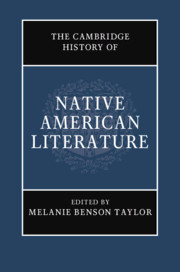Book contents
- The Cambridge History of Native American Literature
- The Cambridge History of Native American Literature
- Copyright page
- Contents
- Figures
- Contributors
- Introduction: What Was Native American Literature?
- Part I Traces and Removals (Pre-1870s)
- 1 Indigenous Languages and the Origins of American Literary History
- 2 Unsettling Colonial Temporalities: Oral Traditions and Indigenous Literature
- 3 Early Native American Literature and Hemispheric Studies
- 4 Performative Cultures of Early America
- 5 Nineteenth-Century American Indian Newspapers and the Construction of Sovereignty
- 6 Indigenous Literacies in Early New England
- Part II Assimilation and Modernity (1879–1967)
- Part III Native American Renaissance (Post-1960s)
- Part IV Visions and Revisions: 21st-Century Prospects
- Index
- References
3 - Early Native American Literature and Hemispheric Studies
from Part I - Traces and Removals (Pre-1870s)
Published online by Cambridge University Press: 18 September 2020
- The Cambridge History of Native American Literature
- The Cambridge History of Native American Literature
- Copyright page
- Contents
- Figures
- Contributors
- Introduction: What Was Native American Literature?
- Part I Traces and Removals (Pre-1870s)
- 1 Indigenous Languages and the Origins of American Literary History
- 2 Unsettling Colonial Temporalities: Oral Traditions and Indigenous Literature
- 3 Early Native American Literature and Hemispheric Studies
- 4 Performative Cultures of Early America
- 5 Nineteenth-Century American Indian Newspapers and the Construction of Sovereignty
- 6 Indigenous Literacies in Early New England
- Part II Assimilation and Modernity (1879–1967)
- Part III Native American Renaissance (Post-1960s)
- Part IV Visions and Revisions: 21st-Century Prospects
- Index
- References
Summary
This chapter takes its cues from Leslie Marmon Silko’s epochal novel Almanac of the Dead in considering the themes of death and survival through transformation, both in the textual history and plot, of Native American literatures throughout the hemisphere. Focusing on the “epic” of Native American literature, the Maya Quiche Book of Counsel, the Popol vuh, the chapter begins by theorizing Native American literatures throughout the Western hemisphere as “writing” in alphabetical script that engages with non-alphabetical pre-Columbian forms of textuality; it proceeds by considering the themes of death, transformation, and survival in the plot of the Popol vuh in light of its textual history—from its pre-Columbian traditions, both hieroglyphic and iconographic, to its alphabetical Maya, Spanish, and ultimately English transmissions. It places particular emphasis on the colonial sociology of the production of the Popol vuh’s first alphabetical transcription in the sixteenth century and of its first Spanish translation during the eighteenth century in the context of mendicant missionary ethnography, which was originally invented as an instrument of ethnocide, namely the extirpation of “idolatry.”
Keywords
- Type
- Chapter
- Information
- The Cambridge History of Native American Literature , pp. 51 - 73Publisher: Cambridge University PressPrint publication year: 2020

